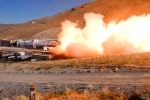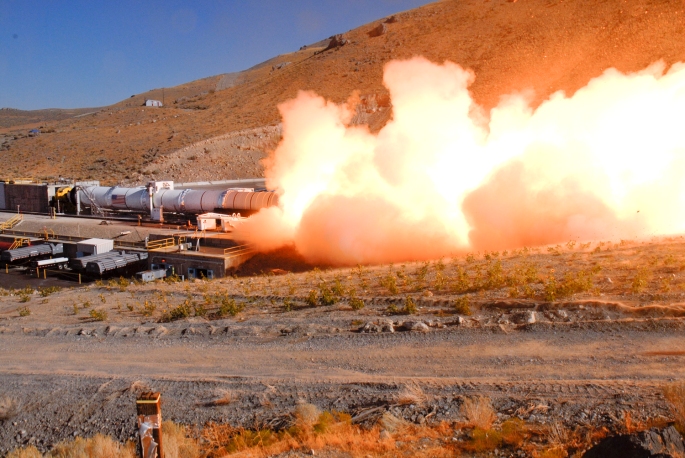
Development Motor-2 not ready for prime time, just yet
Astronomy News – Constellation program testing Development Motor-2 –
Reports of the death of NASA’s Constellation program appear to have been a little premature as rocket scientists were testing Development Motor-2 (DM-2), currently the world’s largest and most powerful solid rocket motor, on August 31 in static tests conducted by ATK Aerospace Systems in Promontory, Utah. The development of the DM-2 has been managed by the Ares Projects Office at NASA’s Marshall Space Flight Center in Huntsville, Alabama, and despite reports that this booster wouldn’t be used in the near future to power Constellation program space vehicles, it appears the DM-2 is being prepared to go to work.
The DM-2 roared-to-life in a mighty column of flame during a two-minute, full-scale testing of the most powerful engine humans have yet designed and built for space travel. The DM-2 is actually suited to be used on heavy-lift vehicles used by the American space program to move heavy loads from Earth into space and it’s still possible we’ll see the DM-2 used for this very job in the future. The stationary firing of the first-stage development solid rocket motor referred to as the DM-2 was monitored by more instruments than at any time in NASA’s history, with a record 760 instruments measuring 53 variables of the test-firing.
The DM-2 is designed to produce about 3.6 million pounds of thrust at ignition, enough power to lift a significant amount of weight mass into space orbit. This full-scale testing of the DM-2 is designed to collect information and data that will be combined with previous tests to allow rocket scientists to better evaluate the potential of the DM-2 for future NASA programs. The DM-2 is similar to the successful solid rocket boosters NASA used to lift the space shuttle into Earth orbit but include significant improvements and upgrades designed by NASA and ATK engineers. Engineers added a fifth segment to the DM-2, a larger nozzle throat, and upgraded the insulation and liners, all additions they expect to make a difference in performance and reliability of the DM-2 as compared to previous rocket engines.
What’s next for the DM-2 and the engineers in charge of its development? After additional testing, the DM-2 will be certified to be used by NASA at temperature ranges between 40 and 90 degrees Fahrenheit. There has been no additional information provided by NASA and ATK concerning future plans for the DM-2, but apparently they have something in the pipeline. We’ll have to wait and see what happens in the months ahead in the century of the environment with the DM-2.
NASA will be looking to private firms for more help during the decades ahead
Read about the present news on the search for life beyond Earth https://spaceshipearth1.wordpress.com/2013/12/25/the-search-for-life-beyond-earth-takes-a-turn-at-jupiter/.
View the latest in high definition images of the solar system provided by NASA’s Cassini spacecraft https://spaceshipearth1.wordpress.com/2013/12/22/cassini-spacecraft-show-views-of-the-solar-system-in-natural-color/.
We tell you about the astronomy highlights upcoming for 2014 https://spaceshipearth1.wordpress.com/2013/12/19/2014-the-journey-ahead/.

